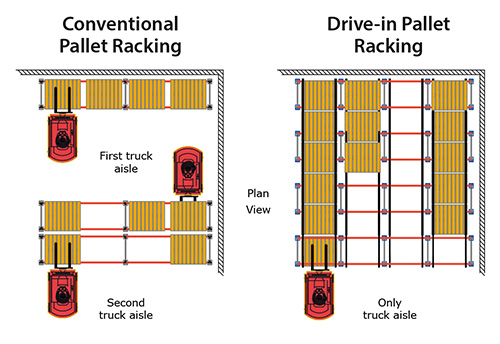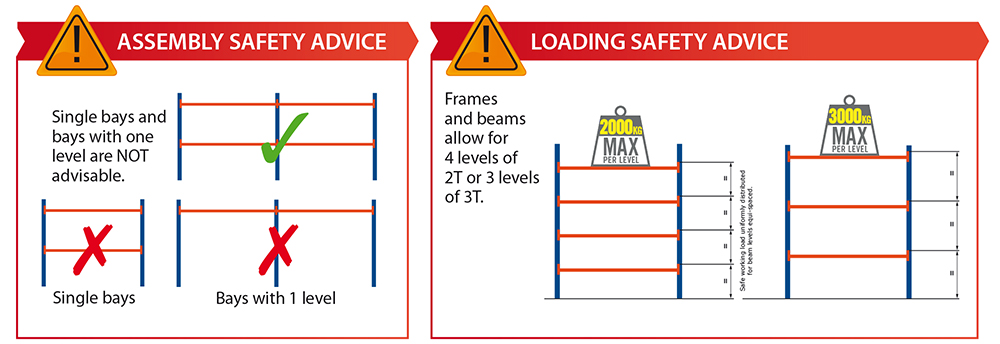Your session is about to timeout due to inactivity. Click OK to extend your time for an additional 120 minutes.
Warehouse management is not a job for the weak, the disorganised or the unmethodical. Managing warehouse operations implies a high level of accountability, dedication and reliability, as to meet even the most basic objectives of a warehouse, such as maximising effective use of space and accessibility of all items.
The warehouse operational process is made of 3 main activity categories: Inbound Activities, such as unloading, counting and registering goods, Process Activities, like stocking, replenishment and space planning, and Outbound Activities, such as loading and shipping. All of these activities are greatly influenced by the type of racking you choose to install in your warehouse and it is utterly important to get it right to begin with, otherwise you risk facing a very expensive re-fit, which will probably also require a very short timeframe.
To that effect, if you want to select, buy and install the best suitable pallet racking system for your warehouse, then you should definitely go for a custom designed solution. However, even bespoke pallet racking designs need careful consideration, as there are many factors to take into account that go beyond budget and finding an experienced and reliable design and installation service.
Know the types of Pallet Racking

As a dedicated warehouse manager, you surely know your storage requirements by heart and you’ve probably already planned for scalability also, but do you know all the types of racking and pallet storage systems out there?
From floor stacking and selective pallet racks to push back systems and drive-through structures, there are many types of racking, all with their advantages and disadvantages, which is why in-depth knowledge of pallet storage methods is the first step towards a proper solution.
The most elementary method of storing pallets is represented by floor stacking and while the method requires virtually no investment and provides great storage density, it has the huge disadvantage of occupying most of your warehouse’s floor space. In addition, you can only stack them if the pallet is actually capable of supporting the load and the level of accessibility to individual pallets is very poor. A step up from floor stacking, selective pallet racking is very popular among UK warehouses. It’s true that they provide low storage density, but they also require low investment in comparison to more dense solutions. Their greatest advantage is that you’ll gain easy accessibility to all pallets and can work on both FIFO and LIFO bases.
Another option would be drive-in, or otherwise drive-through, pallet rack systems. The only difference between the two is that the latter features an entrance at both ends, while drive-in systems only have one entrance at one end. These systems allow fork trucks to be driven into bays and elevate loads and their greatest advantage is the high storage density they offer. Drive-through systems are usually First In First Out, while drive-ins typically allow for Last In First Out. Pallet flow rack systems and push back systems are the other two types of pallet storage and they both offer high storage density, but also require more significant investments. They both use uprights and cross beams, but the push back system is LIFO and the flow system is FIFO.
Know your Pallets
If you operate a small warehouse or your racking needs are not exactly the biggest on the market, then you might just do with pallet racking kits, which are already selected complete systems that suit certain pallet sizes and quantities. While this may be an obviously more economical solution to your pallet storage needs, it also requires that you know exactly the type of pallets coming in your warehouse.
It is a known fact that euro pallets are not as wide as UK pallets, so you’d need different types of frames when you store Euro Pallets as opposed to when you store 1000mm wide or 1200mm wide UK Pallets. The weight of the pallet is also a factor to be taken into account, as it can determine how high you can go with your racking system. Pallet racks can feature 3 or 4 levels or even more, but whether you go for the stocked kits or for custom designs, you need to be aware of the weight you’re placing on the racks.
Height utilisation is an important component of warehouse storage solutions, because wasted space equals wasted money and a properly designed solution will always look to maximise storage space while minimising the use of floor space. This vertical storage solution is also quite economical from an investment point of view, although there’s the additional cost of a racking crane, if you don’t already have one, as to be able to access higher levels.
Call 01285 68 68 68 today
to discuss your project
Know the Safety Regulations

Whether we’re talking fire codes, seismic zones or simply beam capacities which are affected by the loading patterns, when looking to invest in new pallet racking systems for your warehouse, safety regulations are of utter importance. This is one of the main reasons for which design assistance is preferable, as most of these services include help with building and safety regulations and even safe installation services.
Regular inspections are also recommendable, especially for those pallet racking systems that involve mechanical handling equipment. This may not be a regulation or a legal requirement, but it can save you a lot of hassle and money down the road, not to mention it can save lives. Pallets can be stacked and stored on racking systems that go as up as you want, thus making great use of otherwise wasted space, but they don’t fall up, and rack collapses are highly dangerous.
Even though you might have gotten it right the first time, designing and installing your racking systems in compliance with all the codes of practice and all safety regulations, it still pays to conduct your own regular inspections as to assess the integrity of the frames and beams to spot any damages, deflections, dents and other such factors.
Browse our storage designs
design
solutions
solutions
pallet
racking
racking
warehouse shelving
two
tier
tier
stockroom shelving
mobile
shelving
shelving
customised design
partitioning solutions








